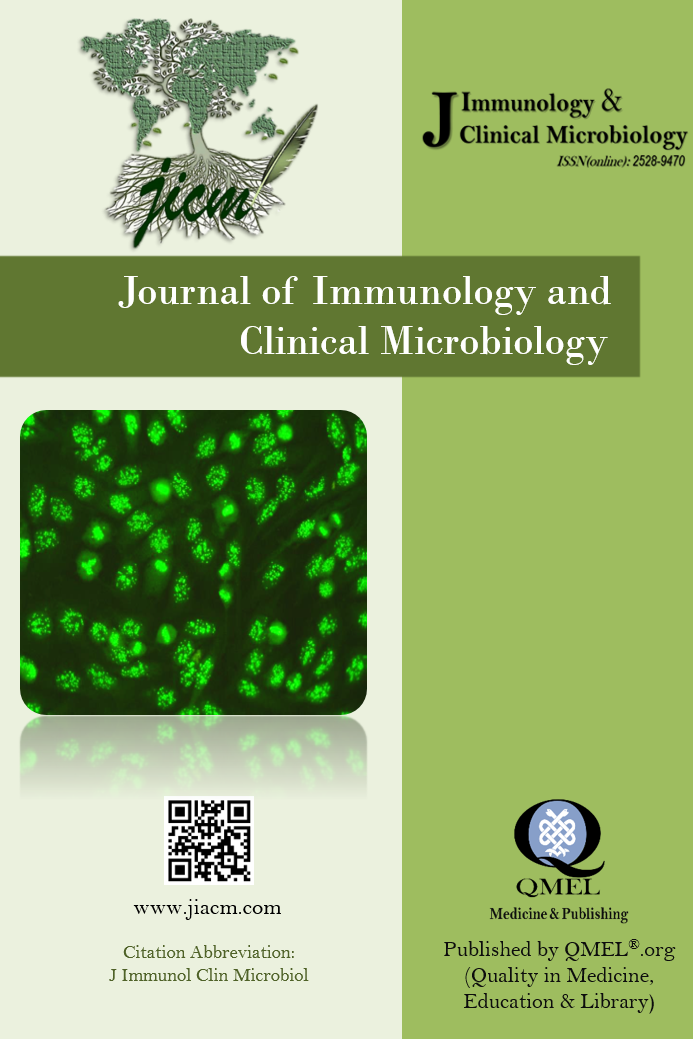Evaluation on the correlation between gender and drug allergy agent and its incidence frequency
Evaluation on the correlation between gender and drug allergy agent and its incidence frequency
gender, drug, drug allergy,
___
- Khan DA, Solensky R. Drug allergy. Journal of Allergy and Clinical Immunology 2010;125(2):126-137.
- Demoly P, Adkinson NF, Brockow K, et al. International Consensus on drug allergy. Allergy. 2014;69(4):420-437.
- Gomes ER, Demoly P. Epidemiology of hypersensitivity drug reactions. Current opinion in allergy and clinical immunology 2005;5(4):309-316.
- Blanca M, Romano A, Torres MJ, et al. Update on the evaluation of hypersensitivity reactions to betalactams. Allergy. 2009;64(2):183-193.
- Bircher AJ, Hofmeier KS, Drug hypersensitivity reactions: Inconsistency in the use of the classification of immediate and nonimmediate reactions. Journal of Allergy and Clinical Immunology 2012;129(1):263.
- Ozturk O, Fidanci I. A general look at pharmacogenetic and its future. Journal of Family Medicine and Health Care 2015;1(3):33-35.
- Lazarou J, Pomeranz BH, Corey PN. Incidence of adverse drug reactions in hospitalized patients: a meta-analysis of prospective studies. Jama. 1998;279(15):1200-1205.
- Classen DC, Pestotnik SL, Evans RS, et al. Adverse drug events in hospitalized patients: excess length of stay, extra costs, and attributable mortality. Jama. 1997;277(4):301-306.
- Temple ME, Robinson RF, Miller JC, Hayes JR, Nahata MC. Frequency and preventability of adverse drug reactions in paediatric patients. Drug safety. 2004;27(11):819-829.
- Impicciatore P, Choonara I, Clarkson A, Provasi D, Pandolfini C, Bonati M. Incidence of adverse drug reactions in paediatric in/out‐patients: a systematic review and meta‐analysis of prospective studies. British journal of clinical pharmacology 2001; 52(1): 77-83.
- Rebelo Gomes E, Fonseca J, Araujo L, Demoly P. Drug allergy claims in children: from self‐reporting to confirmed diagnosis. Clinical & Experimental Allergy 2008; 38(1): 191-198.
- Tan T, Van Bever H. Prevalence of self-reported adverse drug reaction/drug allergy in a Singaporean paediatric population. Journal of Allergy and Clinical Immunology 2007; 119(1): 125.
- Yolsal G. Edirne İl merkezinde kreş ve anaokullarına devam eden çocuklarda astım ve alerjik hastalıkların prevalansının ve alerjik duyarlılığın araştırılması (tez). Edirne: Trakya Üniversitesi Tıp Fakültesi, 2005.
- Orhan F, Karakas T, Cakir M, Akkol N, Bahat E, Sonmez FM, Gedik Y. Parental‐reported drug allergy in 6‐to 9‐yr‐old urban schoolchildren. Pediatric allergy and immunology 2008; 19(1): 82-85.
- Pouyanne P, Haramburu F, Imbs JL, Bégaud B. Admissions to hospital caused by adverse drug reactions: cross sectional incidence study. Bmj 2000; 320(7241): 1036.
- Kidon MI, See Y. Adverse drug reactions in Singaporean children. Singapore Med J. 2004; 45(12): 574-7.
- Riedl MA, Casillas AM. Adverse drug reactions: types and treatment options. American family physician 2003; 68(9): 1781-1790.
- Fattinger K, Roos M, Vergères P, et al. Epidemiology of drug exposure and adverse drug reactions in two Swiss departments of internal medicine. British journal of clinical pharmacology 2000; 49(2): 158-167.
- Kimland E, Rane A, Ufer M, Panagiotidis G. Paediatric adverse drug reactions reported in Sweden from 1987 to 2001. Pharmacoepidemiology and drug safety, 14(7), 493-499.
- Gomes E, Cardoso MF, Praca F, Gomes L, Marino E, Demoly P. Self‐reported drug allergy in a general adult Portuguese population. Clinical & Experimental Allergy 2004; 34(10): 1597-1601.
- Forsting M, Palkowitsch P. Prevalence of acute adverse reactions to gadobutrol—a highly concentrated macrocyclic gadolinium chelate: review of 14,299 patients from observational trials. European journal of radiology 2010; 74(3): 186-192.
- Prince MR, Lee HG, Lee CH, et al. Safety of gadobutrol in over 23,000 patients: the GARDIAN study, a global multicentre, prospective, non-interventional study. European radiology 2017; 27(1): 286-295.
- Gutierrez JE, Koenig S, Breuer J. Overview on the efficacy and safety of gadobutrol: an MRI contrast agent for the CNS, body and vessels. Imaging in Medicine 2012; 4(1): 25.
- Bhargava R, Noga M. Safety and efficacy of gadobutrol-enhanced MRI in patients aged under 2 years-a single-center, observational study. Magnetic Resonance Insights 2013; 6: 1-12.
- Yayın Aralığı: Yılda 4 Sayı
- Başlangıç: 2016
- Yayıncı: Erkan YULA
COVID-19 Hastalarında İmmunokromatografik Antikor Testi Sonuçları
The effects of balneotherapy on depression and anxiety scale scores in patients with osteoarthritis
Arzu DİNÇ YAVAŞ, Ebru UMAY, Mustafa TEZELLİ
Zeynep TANRIVERDİ, Onur YİĞİTASLAN, Salih Atakan NEMLİ, Süreyya GÜL YURTSEVER, Esra BASKURT, Hatice TÜRE, Mehmet ÇELEBİSOY
Kısa Barsak Sendromunda Mikrobiyota ve Pre-Probiyotikler
Eftal GEÇGİL DEMİR, Fatma Bengü KUYULU BOZDOĞAN, Aybala TAZEOĞLU
Ahmet DOĞAN, Hatun ÖZTÜRK ÇERİK, Atila GÜRGEN, Aykut ÖZTURAN
Peripheral Facial Paralysis After COVID-19 Vaccination
Evaluation on the correlation between gender and drug allergy agent and its incidence frequency
İzzet FİDANCI, Mert SATILMIŞ, Duygu AYHAN BAŞER, Hilal AKSOY, Duygu YENGİL TACİ, Mustafa CANKURTARAN
